
Ye Olde Fighting Cocks is a pub in St Albans, Hertfordshire, England. It is one of several pubs that lay claim to being the oldest in England, claiming to have been in business since 793 AD. Its claim to that date is somewhat uncertain: the building is described by Historic England as being of 16th-century appearance, and the earliest date for which it might have been licensed is 1756. Other pubs such as Ye Olde Man & Scythe in Bolton, Greater Manchester, and Ye Olde Trip to Jerusalem in Nottingham also make unproved claims to being the oldest. Ye Olde Fighting Cocks was once listed as the oldest in England by the Guinness World Records, but the record was withdrawn from consideration in 2000 because it was deemed impossible to verify.

Bletchingley is a village in Surrey, England. It is on the A25 road to the east of Redhill and to the west of Godstone, has a conservation area with medieval buildings and is mostly on a wide escarpment of the Greensand Ridge, which is followed by the Greensand Way.

The King William Ale House is a historic public house situated on King Street in Bristol, England. It dates from 1670 and was originally part of a row of three houses. The three have been designated by English Heritage as a grade II* listed building since 8 January 1959. It includes a mixture of 17th-century and 18th-century features, is terracotta coloured, but currently serves as a public house owned and operated by Samuel Smith Old Brewery.

Leche House is at 17 Watergate Street and Row, Chester, Cheshire, England. It is recorded in the National Heritage List for England as a designated Grade I listed building, and incorporates a section of the Chester Rows. It is considered to be the best preserved medieval town house in Chester.

116 Hospital Street is a substantial townhouse in Nantwich, Cheshire, England, located on the south side of Hospital Street. It is listed at grade II. The present building, of Georgian appearance, incorporates an earlier timber-framed house, which probably dates in part from the 15th century. Local historian Jane Stevenson calls it "the most interesting house in Hospital Street", and considers it might be "the oldest surviving residence in Nantwich."

The Stag Inn is a public house in the Old Town area of Hastings, a port and seaside resort in East Sussex, England. One of many ancient buildings on All Saints Street, the 16th-century timber-framed inn was refronted in the 18th century, but many of its original features remain. The preserved bodies of two smoke-blackened mummified cats have been displayed on a wall since their discovery in the 19th century; witchcraft has been suggested as an explanation for this "grisly sight". The inn, which claims to be Hastings' oldest surviving pub, is operated as a tied house by the Shepherd Neame Brewery, and has been listed at Grade II by English Heritage for its architectural and historical importance.
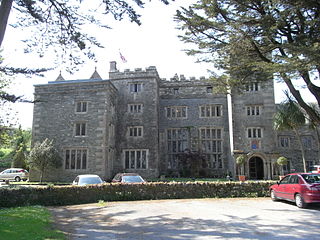
Boringdon Hall is a 16th-century Grade I listed manor house in the parish of Colebrook, about two miles north of Plympton, Devon.

The hall house is a type of vernacular house traditional in many parts of England, Wales, Ireland and lowland Scotland, as well as northern Europe, during the Middle Ages, centring on a hall. Usually timber-framed, some high status examples were built in stone.

Harlington Manor is a grade II* listed manor house in Harlington, Bedfordshire. The house abuts, and has views over, Bury Orchard, the village common, which itself abuts the Chilterns Area of Outstanding Natural Beauty.

Plympton House is the principal residence at the Plympton House Estate, in the parish of Plympton St Maurice, Devon, England. It is a Grade I listed country house, in the William and Mary tradition, near St Maurice's Church in Plympton, commenced by Sir George Treby (1643–1700) and completed c. 1715 – 1720 by his son George Treby. The architect is unknown although accounts in 1720 refer to William Veale, mason. Its kitchen garden wall, southern boundary walls and gate piers and walls are Grade II listed.

The Royal Oak is a Grade II-listed house in Frindsbury, a Medway town in Kent, United Kingdom. The building dates from the late 17th century and it was used as a public house since before 1754. It is one of a few pre-Victorian buildings on Cooling Road in Frindsbury and one of the last remaining coach houses in the area.
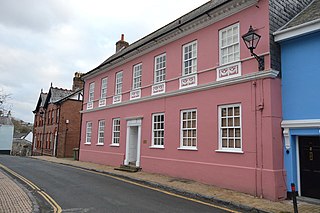
The Old Rectory is a grade II* listed townhouse in Plympton, Devon, England. It was listed on 23 April, 1952.

Barnston Manor is a 13th-century manor house and farm near Church Knowle in Dorset, England. The house is a Grade I listed building, and some farm buildings at the property are also Grade II listed.
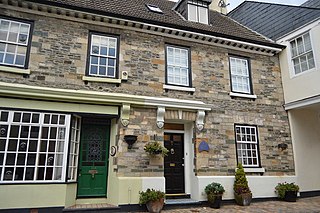
Chapel House is a Grade II listed building in Plympton, Devon, England. Standing at 10a and 10b Fore Street, Plympton's main street, it is believed to have originally been a town house, later developed into a shop with attached house. It dates to the mid-18th century, but contains older remnants.
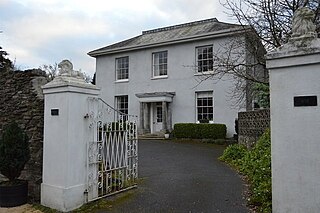
The Lodge is a Grade II listed building in Plympton, Devon, England. Standing at 103 Fore Street, the western end of Plympton's main street, it is a detached villa dating to the early- or mid-19th century.
Tan Cottage is a Grade II listed building in Plympton, Devon, England. It stands in Plympton's main street at 49 Fore Street, behind numbers 45 and 47, and dates mainly to the 17th century, when it was used as a tannery.
Carlton House is a Grade II listed building in Plympton, Devon, England. Standing at 43 Fore Street, Plympton's main street, it dates to the early 19th century.
24 Fore Street is a Grade II listed building in Plympton, Devon, England. Standing on Plympton's main street, it dates to the late 18th century.
Tudor Lodge is a Grade II* listed building in Plympton, Devon, England. Standing at 63 Fore Street, Plympton's main street, it dates to the late 17th century.
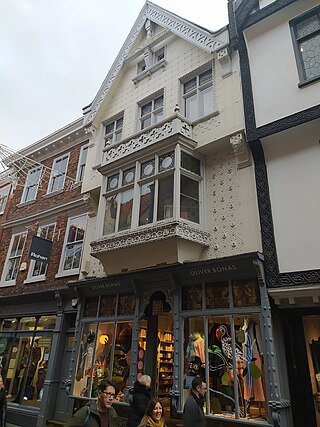
35 Stonegate is a grade II* listed building in the city centre of York, in England.


















